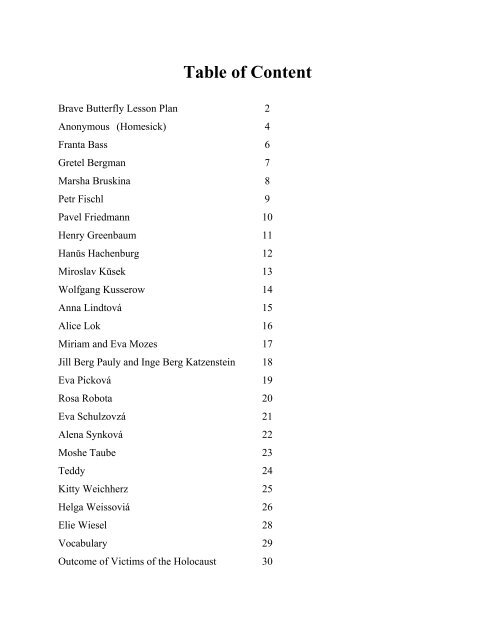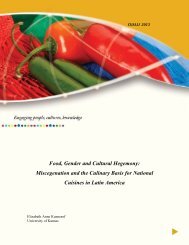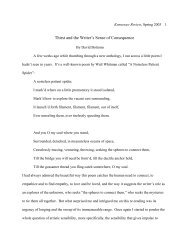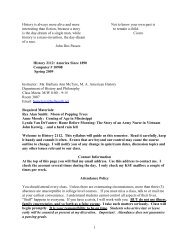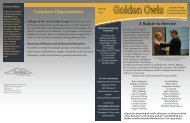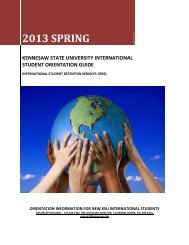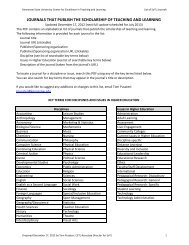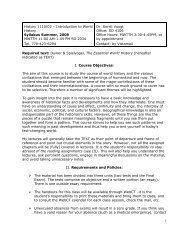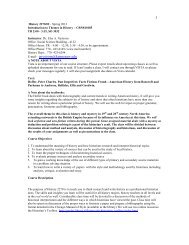Brave Butterflies lesson Plan - Kennesaw State University
Brave Butterflies lesson Plan - Kennesaw State University
Brave Butterflies lesson Plan - Kennesaw State University
Create successful ePaper yourself
Turn your PDF publications into a flip-book with our unique Google optimized e-Paper software.
Table of Content<br />
<strong>Brave</strong> Butterfly Lesson <strong>Plan</strong> 2<br />
Anonymous (Homesick) 4<br />
Franta Bass 6<br />
Gretel Bergman 7<br />
Marsha Bruskina 8<br />
Petr Fischl 9<br />
Pavel Friedmann 10<br />
Henry Greenbaum 11<br />
Hanŭs Hachenburg 12<br />
Miroslav Kŭsek 13<br />
Wolfgang Kusserow 14<br />
Anna Lindtová 15<br />
Alice Lok 16<br />
Miriam and Eva Mozes 17<br />
Jill Berg Pauly and Inge Berg Katzenstein 18<br />
Eva Picková 19<br />
Rosa Robota 20<br />
Eva Schulzovzá 21<br />
Alena Synková 22<br />
Moshe Taube 23<br />
Teddy 24<br />
Kitty Weichherz 25<br />
Helga Weissoviá 26<br />
Elie Wiesel 28<br />
Vocabulary 29<br />
Outcome of Victims of the Holocaust 30
<strong>Brave</strong> <strong>Butterflies</strong><br />
Students will:<br />
• learn about the fate of many children during the Holocaust<br />
• discover some of the feelings children experienced during the Holocaust through poetry<br />
• create a butterfly to represent the life of the person they have an opportunity to explore<br />
• discuss what happens when innocent children are targeted because of their religion, race, or<br />
nationality<br />
• understand the loss of potential from the Holocaust<br />
• see that there are ways to combat Anti-Semitism, racism, prejudice, and genocide<br />
Materials:<br />
• Individual Story Worksheets (there are a couple of worksheets that contain stories of two<br />
sisters; assign 2 students to those worksheets and assign each student one of the sisters.<br />
Have them create a butterfly for their sister only.)<br />
• Outcome of Each Holocaust Victim<br />
• Vocabulary list<br />
• Art supplies of your choice: colored paper, glue scissors, glitter, pipe cleaners (see guidelines<br />
below for selecting materials)<br />
• Oak Tag cut into strips 18”x 2” wide<br />
• Markers<br />
• Stapler<br />
• Tape<br />
• String<br />
• Hole punch<br />
• Large shoebox covered in black construction paper (big enough to fit the largest butterfly)<br />
Activity:<br />
• Before you start, place all the art materials on a work table<br />
• Place the vocabulary list on the board and have the class help to define the terms. Write<br />
their answers on the board.<br />
• Hand out the Individual Story Worksheets and remember there are a couple of worksheets<br />
that contain stories of two sisters; assign 2 students to those worksheets and assign each student<br />
one of the sisters. Have students read silently their worksheet. DO NOT have students<br />
share their stories until later.<br />
• Butterfly guidelines: make butterflies 9”x12” or smaller, if 2-dimensional they must be cut<br />
out in the shape of a butterfly, make them durable, double sided if possible, can have a message<br />
or meaningful symbolism on the wings or body. Please have student avoid using the<br />
Nazi Swastika.<br />
• Allow students to select the materials they want to use to create their butterfly and set aside<br />
time for them to complete the art work.<br />
• After they have finished their butterfly pass out the 18”x2” oak tag strips, a piece of string<br />
about 20’ long, and markers. Have them write the name of their person on both sides of the<br />
oak tag strip and punch a hole in the bottom of the strip (you should be able to read the<br />
name above the hole.) Tie the string through the hole and then staple or tie the string to the
middle of the butterfly so it will hang like it’s flying.<br />
• Now staple or tape all of the butterflies to the ceiling of the classroom.<br />
• Allow the butterflies to hang for at least a day so the students can admire them.<br />
• Next, each student will present the brief biography along with any poems or diary excerpts.<br />
Have them point out the butterfly that represents their person and then tell them that person’s<br />
fate. If the person died during the Holocaust have them cut the butterfly down and<br />
place it in the shoebox. Be sure the name strip remains hanging from the ceiling as a memorial<br />
to that lost soul. If the person survived the butterfly will remain hanging from the ceiling.<br />
If their person perished have students calculate their age at the time of death.<br />
• After all students have presented lead a discussion with the following objectives in mind:<br />
1.5 million Jewish children died<br />
The tremendous loss of hope, dreams, potential (what could these children have<br />
contributed to society)<br />
What was their crime? Why were they targeted for death?<br />
Who could have helped?<br />
Loss of their human dignity, civil rights, legacy<br />
Is there genocide going on today?<br />
How do we prevent genocide from happening?<br />
• What are the signs of Genocide?<br />
Killing members of a group of people<br />
Causing serious bodily or mental harm to members of a group of people<br />
Imposing measures intended to prevent births within a group of people<br />
Forcibly transferring children of the group to another group of people<br />
• What can we do to prevent genocide?<br />
Paying attention to how countries are treating their people<br />
Respecting differences in ideas, beliefs, religion, culture<br />
Believing in the positive power of diversity<br />
Being vocal about our governments role in stopping genocide<br />
Homework or follow up assignment:<br />
• At the bottom of each biography there is a word or phrase, which can be researched by the student.<br />
It can be an assignment that ranges from a few paragraphs to an extensive research paper.<br />
This <strong>lesson</strong> has been adapted from the Holocaust Museum Houston’s I Never Saw Another Butterfly<br />
teaching activity (http://www.hmh.org/minisite/butterfly/activity5.html)<br />
Connections to GPS:<br />
SSWH18 The student will demonstrate an understanding of the global political, economic, and<br />
social impact of World War II.<br />
b. Identify Nazi ideology, policies, and consequences that led to the Holocaust.<br />
ELA9RL2 The student identifies, analyzes, and applies knowledge of theme in literary<br />
works from various genres and provides evidence from the works to support<br />
understanding. (a,b)<br />
ELA9RL3 The student deepens understanding of literary works by relating them to
contemporary context or historical background. (a)<br />
ELA9RL4 The student employs a variety of writing genres to demonstrate a<br />
comprehensive grasp of significant ideas in sophisticated literary works. The<br />
student composes essays, narratives, poems, or technical documents. (a,b)<br />
ELA9RL5 The student understands and acquires new vocabulary and uses it correctly<br />
in reading and writing. (a,c)<br />
QCC: World History:<br />
Topic 18: Impact of ideas, Individuals, and History<br />
Topic 23: Human Rights<br />
This <strong>lesson</strong> plan was adapted from educational materials Holocaust Museum Houston.<br />
____________________________________________________________________________________________<br />
This <strong>lesson</strong> plan was created to complement <strong>Kennesaw</strong> <strong>State</strong> <strong>University</strong>’s Holocaust Education Butterfly<br />
Exhibition. For more information please go to our website<br />
www.kennesaw.edu or call 678-797-2083
Alena Synková was born in Prague, Czechoslovakia in September 24, 1926. She was sent<br />
to Terezin on December 22, 1942. Terezin camp was designed by Nazis as a model<br />
Jewish settlement, but in reality it was a concentration camp. Terezin was also used as a<br />
transit camp for Jews en route to Auschwitz and other extermination camps.<br />
I’d Like To Go Alone<br />
I’d like to go away alone<br />
Where there are other, nicer people,<br />
Somewhere into the far unknown.<br />
Maybe more of us,<br />
A thousand strong,<br />
Will reach this goal<br />
Before too long.<br />
Theme:<br />
Terezin Camp<br />
This <strong>lesson</strong> plan was created to complement <strong>Kennesaw</strong> <strong>State</strong> <strong>University</strong>’s Holocaust Education<br />
Butterfly Exhibition. For more information please go to our website<br />
www.kennesaw.edu or call 678-797-2083
Alice Lok<br />
Alice Lok lost her entire family by age seventeen. One day, it was her turn to go to the “showers,” too.<br />
She was told to undress; the Nazis had decided that she was on longer of use to them. She entered the<br />
gas chambers on October 7, 1944, on the same day as the Sonderkommando uprising. Along with other<br />
women, the Nazis ordered her out, and she survived. However, Alice was forced on a death march to<br />
Bergen-Belsen.<br />
“Six people slept on a plank of wood, on top of us another layer, and if one of us turned, all the others<br />
had to turn because it was so narrow. One cover, no pillow, no mattress.” —Alice Lok<br />
Theme:<br />
Sonderkommando<br />
This <strong>lesson</strong> plan was created to complement <strong>Kennesaw</strong> <strong>State</strong> <strong>University</strong>’s Holocaust Education<br />
Butterfly Exhibition. For more information please go to our website<br />
www.kennesaw.edu or call 678-797-2083
Anna Lindtová was born on March 19, 1930. She was sent to Terezin from Prague,<br />
Czechoslovakia on May 12, 1942 at the age of 12. While in Terezin she wrote poems. Terezin<br />
was created by the Nazis as a model Jewish settlement, but in reality it was a concentration<br />
camp. Terezin was also used as a transit camp for Jews en route to Auschwitz and other<br />
extermination camps.<br />
Theme:<br />
Auschwitz<br />
Campfire<br />
Here I sit on a rock<br />
in front of the campfire.<br />
One branch after another<br />
is snatched by the fire.<br />
Into the darkness<br />
the forest recedes.<br />
Fire makes one reflect…<br />
Terezin is all I think about.<br />
But now memories gather ‘round me<br />
like the falling leaves.<br />
Fall is here.<br />
The leaves turn yellow on the trees,<br />
the campfire dies out.<br />
My thoughts are far from here,<br />
somewhere far,<br />
where integrity lives.<br />
It lives in my friend.<br />
Now I think of her.<br />
Memories gather ‘round me<br />
like the falling leaves.<br />
This <strong>lesson</strong> plan was created to complement <strong>Kennesaw</strong> <strong>State</strong> <strong>University</strong>’s Holocaust Education Butterfly<br />
Exhibition. For more information please go to our website<br />
www.kennesaw.edu or call 678-797-2083
Elie Wiesel<br />
Elie Wiesel was born in 1928 in Sighet, Transylvania (now Romania), in a community centered on<br />
religious study. His hometown of Sighet was annexed into Hungary in 1940 and all the Jewish residents<br />
were placed into one of two the ghettos in the city. The Wiesel family lived in the larger ghetto on<br />
Serpent Street. On April 19, 1944, at the age of fifteen, the Nazis deported the Jewish inhabitants of his<br />
town to Auschwitz in Poland. Elie, like all concentration camp prisoners, was tattooed with a number on<br />
their left arm. His number was A-7713. Elie Wiesel was separated from his mother and sisters and later<br />
was sent with his father to Buchenwald work camp in Germany.<br />
“Never shall I forget that first night, the first night in the camp, which turned my life into one long<br />
night.” –Elie Wiesel, Night<br />
Theme:<br />
Night<br />
This <strong>lesson</strong> plan was created to complement <strong>Kennesaw</strong> <strong>State</strong> <strong>University</strong>’s Holocaust Education<br />
Butterfly Exhibition. For more information please go to our website<br />
www.kennesaw.edu or call 678-797-2083
Eva Picková was born in Nymburk, Czechoslovakia on May 15, 1929 and was sent to Terezin on<br />
April 16, 1942. Eva wrote poems while living in the camp. Terezin was presented by the Nazis<br />
as a model Jewish settlement, but in reality it was a concentration camp. Terezin was also used<br />
as a transit camp for European Jews en route to Auschwitz and other extermination camps.<br />
Fear<br />
Today the ghetto knows a different fear,<br />
Close in its grip, Death wields au icy scythe.<br />
An evil sickness spreads a terror in its wake,<br />
The victims of its shadow weep and writhe.<br />
Today a father’s heartbeat tells his fright<br />
and mothers bend their heads into their hands.<br />
Now children choke and die with typhus here,<br />
A bitter tax is taken from their bands.<br />
My heart still beats inside my breast<br />
while friends depart for other worlds.<br />
Perhaps it’s better – who can say?<br />
Than watching this, to die today?<br />
Theme:<br />
Rise of Fascism<br />
No, no, my God, we want to live!<br />
Not watch our numbers melt away.<br />
We want to have a better world,<br />
We want to work – we must not die!<br />
This <strong>lesson</strong> plan was created to complement <strong>Kennesaw</strong> <strong>State</strong> <strong>University</strong>’s Holocaust Education Butterfly<br />
Exhibition. For more information please go to our website<br />
www.kennesaw.edu or call 678-797-2083
Eva Schulzovzá was born on July 20, 1931. While living at Terezin she wrote poems.<br />
Terezin was designed by the Nazis as a model Jewish settlement, but in reality it was a<br />
concentration camp. Terezin was also used as a transit camp for Jews en route to<br />
Auschwitz and other extermination camps.<br />
Theme:<br />
Aryan Race<br />
An Evening In Terezin<br />
The sun goes down<br />
and everything is silent,<br />
only at the guard’s post<br />
are heavy footfalls heard.<br />
That’s the guard who watches his Jews<br />
to make sure they don’t run away from the ghetto,<br />
or that an Aryan aunt or uncle doesn’t try to get in.<br />
Ten o’clock strikes suddenly,<br />
and the windows of Dresden’s barracks darken.<br />
The women have a lot to talk about;<br />
they remember their homes,<br />
and dinners they made.<br />
Then some of them argue.<br />
Others try to quiet them down.<br />
Finally, one by one, they grow silent;<br />
they toss and turn, and in the end,<br />
they fall asleep.<br />
How many more evenings<br />
will we have to live like this?<br />
We do not know,<br />
only God knows.<br />
This <strong>lesson</strong> plan was created to complement <strong>Kennesaw</strong> <strong>State</strong> <strong>University</strong>’s Holocaust Education<br />
Butterfly Exhibition. For more information please go to our website<br />
www.kennesaw.edu or call 678-797-2083
Franta Bass was born in Brno, Czechoslovakia on September 4, 1930 and he was sent to<br />
Terezin concentration camp on December 2, 1941. This camp was created by the Nazis as<br />
a model Jewish settlement, but in reality it was a concentration camp. Terezin was also<br />
used as a transit camp for Jews en route to Auschwitz and other extermination camps.<br />
I Am A Jew<br />
I am a Jew and will be a Jew forever.<br />
Even if I should die from hunger,<br />
Never will I submit.<br />
I will always fight for my people,<br />
On my honor.<br />
I will never be ashamed of them.<br />
I give my word.<br />
I am proud of my people,<br />
how dignified they are.<br />
Even though I am suppressed,<br />
I will always come back to life.<br />
Theme:<br />
Judaism<br />
This <strong>lesson</strong> plan was created to complement <strong>Kennesaw</strong> <strong>State</strong> <strong>University</strong>’s Holocaust Education<br />
Butterfly Exhibition. For more information please go to our website<br />
www.kennesaw.edu or call 678-797-2083
Gretel Bergman<br />
Gretel Bergman had become the 4 th ranked German high jumper at age 16 in 1930. Shortly after<br />
Hitler took over the German government in 1933, Gretel and other Jewish athletes were barred from<br />
local sports clubs. Jewish athletes were no longer allowed to set foot in the stadium, even as a<br />
spectator and there were signs that stated No Jews or Dogs Allowed. When she was denied entry into<br />
the <strong>University</strong> of Berlin, she fled to London. The United <strong>State</strong>s threatened a boycott of the Olympic<br />
Games, scheduled for Berlin in 1936, unless Jewish athletes were allowed to participate. The Nazis<br />
urged Gretel to return in 1935 with the promise that she would compete. Gretel returned and trained<br />
for the 1936 Olympics, however after America’s Olympians set sail for German she was told she had<br />
not made the German team.<br />
“100,000 spectators seeing a Jew win would’ve been heaven.” —Gretel Bergman<br />
Theme:<br />
1936 Olympics<br />
This <strong>lesson</strong> plan was created to complement <strong>Kennesaw</strong> <strong>State</strong> <strong>University</strong>’s Holocaust Education<br />
Butterfly Exhibition. For more information please go to our website<br />
www.kennesaw.edu or call 678-797-2083
Hanŭs Hachenburg was born in Prague, Czechoslovakia on July 12, 1929. He wrote this poem<br />
while in a concentration camp. Hanŭs was sent to Terezin on October 24, 1942. Terezin was<br />
designed by the Nazis as a model Jewish settlement, but in reality it was a concentration<br />
camp. Terezin was also used as a transit camp for Jews being sent to Auschwitz and other<br />
extermination camps.<br />
Theme:<br />
Life in the ghetto<br />
Terezin<br />
That bit of filth in dirty walls,<br />
and all around barbed wire.<br />
and 30,000 souls who sleep<br />
who once will wake<br />
and once will see<br />
their own blood spilled.<br />
I was once a little child,<br />
Three years ago,<br />
that child who longed for other worlds.<br />
But now I am no more a child<br />
For I have learned to hate.<br />
I am a grown-up person now,<br />
I have known fear.<br />
Bloody words and a dead day then,<br />
That’s something different than the bogeyman!<br />
But anyway, I still believe I only sleep today,<br />
That I’ll wake up, a child again, and start to laugh and play.<br />
I’ll go back to childhood sweet like a briar rose,<br />
Like a bell that wakes us from a dream.<br />
Like a mother with an ailing child<br />
Loves him with aching woman’s love.<br />
How tragic, then is youth that lives<br />
With enemies, with gallows rope,<br />
How tragic, then, for children on your lap<br />
To say: this for the good, that for the bad.<br />
This <strong>lesson</strong> plan was created to complement <strong>Kennesaw</strong> <strong>State</strong> <strong>University</strong>’s Holocaust Education Butterfly<br />
Exhibition. For more information please go to our website<br />
www.kennesaw.edu or call 678-797-2083
Helga Weissoviá was born in Prague, Czechoslovakia on November 10, 1929. At the age<br />
of 12 she was already a gifted artist. Helga was sent to Terezin along with her parents on<br />
December 17, 1941. She kept a diary for the 2 ½ years she spent in Terezin. Terezin camp<br />
was created by the Nazis as a model Jewish settlement, but in reality it was a concentration<br />
camp. It was designed to cover up the acts of genocide performed by the Nazis. In 1944,<br />
the American Red Cross, during an inspection, was tricked into believing Nazi treatment of<br />
Jews was not cruel or brutal. Terezin was made to appear as beautiful and serene, thus<br />
preventing the truth about treatment of Jews in Nazi Germany. An excerpt from Helga’s<br />
diary details how the camp was suddenly improved in an attempt to “fool” the commission<br />
inspecting the camp.<br />
Preparing For The Commission’s Visit<br />
…The camp command issued new orders about the “beautifying campaign” that must be<br />
finished in two months.<br />
It’s ridiculous, but it seems that Terezin is to be changed into to a sort of spa.<br />
…all of the sudden the Germans had an idea, and overnight signs had to be put on every<br />
corner house with the name of the street, and at crossroads arrows pointed: To the Park, To<br />
the Bath, etc….<br />
The school building that had served as a hospital up to today was cleared out overnight<br />
and the patients put elsewhere while the whole building was repainted, scrubbed up, school<br />
benches brought in, and in the morning a sign could be seen afar: “Boys’ and “Girls’<br />
School.” It really looked fine, like a real school, only the pupils and teachers are missing.<br />
The short coming is adjusted by a small note on the door: “Holidays.” On the square the<br />
newly sown grass is coming up, the center is adorned by a big rose plot, and paths, covered<br />
with clean, yellow sand…
…..They have already got quite far in painting the houses….In two of the barracks some<br />
bunks and shelves were painted yellow and they got blue curtains. In the park in front of<br />
the Infant’s Home they put a luxury pavilion with cribs and light blue, quilted covers. In<br />
one room there are toys, a carved rocking horse, and so on. None of us can explain why<br />
they are doing all this. Are they so concerned about the commission?<br />
Theme:<br />
Red Cross Inspection of Terezin on June 23, 1944<br />
This <strong>lesson</strong> plan was created to complement <strong>Kennesaw</strong> <strong>State</strong> <strong>University</strong>’s Holocaust Education<br />
Butterfly Exhibition. For more information please go to our website<br />
www.kennesaw.edu or call 678-797-2083
Henry Greenbaum<br />
The youngest of nine children, Henry Greenbaum was born in Starachowice, Poland, in 1928. At the age<br />
of twelve, Henry and his family were sent to the town’s ghetto. They remained there until late 1942<br />
when he and three of his sisters were chosen to work in a slave labor camp. There, Henry worked in a<br />
munition factory. In 1943, Henry and one of his three sisters, Faiga, tried to escape. Henry was wounded<br />
when he was shot in the head, and Faiga was killed. Henry was first sent to Auschwitz and forced to<br />
work for I. G. Farben Company. He was then relocated to the Flossenburg concentration camp in<br />
Germany in early 1945 and then forced to take a three-month death march deeper into Germany.<br />
"Your bravery allowed me to live again. Your courage gave me my freedom." —Henry Greenbaum,<br />
speaking at age 76 to a group of World War II veterans<br />
Theme:<br />
Death Marches<br />
This <strong>lesson</strong> plan was created to complement <strong>Kennesaw</strong> <strong>State</strong> <strong>University</strong>’s Holocaust Education<br />
Butterfly Exhibition. For more information please go to our website<br />
www.kennesaw.edu or call 678-797-2083
Terezin was created by the Nazis as a model Jewish settlement, but in reality it was a<br />
concentration camp. Many artist and intellectuals were sent to Terezin and they took<br />
every opportunity to nurture a cultural environment. Drawing and Poetry were a means<br />
for expressing these dark times in the young lives of these Jewish captives. The<br />
children’s art of Terezin are among the most moving documents of the Holocaust. 15,000<br />
children under the age of fifteen were sent to Terezin and less than 100 survived. Many<br />
of the children’s poems were signed, but others were not. The author of the poem below<br />
is unknown.<br />
Homesick<br />
I’ve lived in the ghetto here for more than year.<br />
in Terezin, in the black town now,<br />
and when I remember my home so clear,<br />
I can love it more than I did, somehow.<br />
Ah, home, home,<br />
Why did they tear me away?<br />
Here the weak die easy as a feather<br />
and when they die, they die forever.<br />
I’d like to go back home again,<br />
It makes me think of sweet flowers.<br />
Before, when I used to live at home,<br />
it never seemed so dear and fair.<br />
I remember now those golden days…<br />
But maybe I’ll be going there soon again.
People walk along the street,<br />
You see at once on each you meet<br />
That there’s ghetto here,<br />
a place of evil and fear.<br />
There’s little to eat and much to want,<br />
where bit by bit, it’s horror to live.<br />
But no one must give in!<br />
The world turns and times change.<br />
Yet we all hope the time will come<br />
when we’ll go home again.<br />
Now I know how dear it is<br />
and often I remember it.<br />
9/3/1943 Anonymous<br />
Theme:<br />
Lodz Ghetto<br />
This <strong>lesson</strong> plan was created to complement <strong>Kennesaw</strong> <strong>State</strong> <strong>University</strong>’s Holocaust Education<br />
Butterfly Exhibition. For more information please go to our website<br />
www.kennesaw.edu or call 678-797-2083
Jill Berg Pauly and Inge Berg Katzenstein<br />
Giesella (Jill) and Inge Berg lived in a rural area outside of Cologne, Germany, where their father was a<br />
cattle dealer. Observant Jews, the Bergs conducted business with both Jewish and non-Jewish families in<br />
the area. Because of these relationships, the Bergs were warned of impending danger in November 1938.<br />
They fled to the city of Cologne before the violence of Kristallnacht destroyed their home. Jill’s father,<br />
uncle, and a male cousin fled to Holland only to be arrested upon arrival. A distant relative made<br />
arrangements for the Berg family to move to Kenya in 1939. After a nine-month internment, Jill’s male<br />
relatives were released from prison in Holland and allowed to make the trip to Africa. In June 1939, 6-<br />
year-old Jill, 10-year-old Inga, and 17 of their family members moved to a farm in Limuru. The Bergs<br />
were considered “enemy aliens” in Africa.<br />
“I could not speak, I could not call attention to myself, I could not fight with my sister, I could not ask<br />
for a drink of water. I just had to sit in the compartment and be quiet.” —Jill Pauly upon leaving<br />
Cologne for Genoa, June 1939<br />
Themes:<br />
Escaped Jews In Africa<br />
World Response to Fleeing Jews<br />
This <strong>lesson</strong> plan was created to complement <strong>Kennesaw</strong> <strong>State</strong> <strong>University</strong>’s Holocaust Education<br />
Butterfly Exhibition. For more information please go to our website<br />
www.kennesaw.edu or call 678-797-2083
Kitty Weichherz<br />
Béla Weichherz began a diary when his wife Esti gave birth to the couple's only daughter Kitty in<br />
December 1929, the same year as Anne Frank. In it, this adoring father recorded his daughter's<br />
development in minute detail. The Weichherz's did not actively embrace a Jewish identity or life.<br />
Like many acculturated middle-class Jewish families in Bratislava, Czechoslovakia, they spoke<br />
German at home, although Kitty also learned Slovak, Czech, and Hungarian. Soon after Germany<br />
annexed the Sudetenland in October 1938, Czechoslovakia ceased to exist. Slovakia gained<br />
independence and became a Nazi puppet state that harshly persecuted its Jews. Béla lost his job as a<br />
traveling salesman and Kitty was forced to attend a Jewish school. The Weichherz's were evicted<br />
from their apartment and moved in with relatives in the northern town of Čadca. In March 1942,<br />
deportations of Slovak Jews to Auschwitz began.<br />
“I only wish that we can go together. . . . Kitty is strong for her age but one would like to help a child<br />
in a situation like this.” –Bela Weincherz’s final diary entry, 1942<br />
Theme:<br />
Anti-Semitism<br />
This <strong>lesson</strong> plan was created to complement <strong>Kennesaw</strong> <strong>State</strong> <strong>University</strong>’s Holocaust Education<br />
Butterfly Exhibition. For more information please go to our website<br />
www.kennesaw.edu or call 678-797-2083
Masha Bruskina<br />
Born in 1924, Masha lived in the Minsk ghetto in 1941 and worked as a medical assistant in a hospital<br />
for Soviet prisoners of war. To aide the underground resistance in Minsk, which had been established in<br />
August 1941, Buskina supplied civilian clothes and false documents to escaping Soviet officers. Nearly<br />
10,000 people escaped the ghetto to form partisan units aiming to sabotage the Nazi war effort. Sadly,<br />
the Germans killed most of the escapees. After a few months at the hospital, Masha and other members<br />
of her group were denounced and arrested in the summer of 1941. Imprisoned and tortured for days by<br />
the Nazis, she never gave up any secrets of the resistance movement.<br />
“If you can, please send me my dress, my green blouse, and white socks. I want to be dressed decently<br />
when I leave here.” —Masha Bruskina in an October 20, 1941 letter to her mother after being arrested<br />
by the Nazis<br />
Theme:<br />
Underground Resistance<br />
This <strong>lesson</strong> plan was created to complement <strong>Kennesaw</strong> <strong>State</strong> <strong>University</strong>’s Holocaust Education<br />
Butterfly Exhibition. For more information please go to our website
Miriam and Eva Mozes<br />
Twins Miriam and Eva Mozes were born in 1934 in a small Romanian village, Portz, and were the only<br />
Jewish family in the small town. Early in 1944, their family was sent to a ghetto in Simleul Silvanieni<br />
and finally sent to Auschwitz. Once the girls were identified as twins, they became subjects of Dr.<br />
Joseph Mengele’s cruel and inhumane medical experiments. Eva was given five injections, which gave<br />
her a high fever and caused her arms and legs to swell. During their ordeal Eva and Miriam were put<br />
through many extremely brutal surgeries and experiments by Dr. Mengele. All twins at Auschwitz were<br />
examined from head to toe and measurements of every inch were taken. Some were given injections in<br />
an attempt to change their eye color others were received lethal doses of germs to see how they would<br />
react and what medications might save them.<br />
“I often say that we, the Mengele twins, are the children without a childhood.” —Eva Mozes Kor<br />
Themes:<br />
Medical Experiments<br />
Eugenics<br />
This <strong>lesson</strong> plan was created to complement <strong>Kennesaw</strong> <strong>State</strong> <strong>University</strong>’s Holocaust Education<br />
Butterfly Exhibition. For more information please go to our website<br />
www.kennesaw.edu or call 678-797-2083
Miroslav Kŭsek was born on March 30, 1932 in the city of Hořelice in Bohemia. He was<br />
sent to Terezin ghetto on February 15, 1942. Terezin was created by the Nazis as a model<br />
Jewish settlement, but in reality it was a concentration camp. Terezin was also used as a<br />
transit camp for Jews en route to Auschwitz and other extermination camps. Miroslav<br />
was deported to Auschwitz.<br />
It All Depends On How You Look At It<br />
I.<br />
Terezin is full of Beauty.<br />
It’s in your eyes now clear<br />
And through the street the tramp<br />
of many marching feet.<br />
In the ghetto at Terezin,<br />
It looks that way to me,<br />
is a square kilometer of earth<br />
cut off from the world that’s free.<br />
Theme:<br />
II.<br />
Death, after all, claims everyone,<br />
you find it everywhere.<br />
It catches up with even those<br />
Who wear their noses in the air.<br />
The whole, wide world is ruled<br />
with a certain justice, so<br />
that helps perhaps to sweeten<br />
the poor man’s pain and woe.<br />
Nuremberg Trials<br />
This <strong>lesson</strong> plan was created to complement <strong>Kennesaw</strong> <strong>State</strong> <strong>University</strong>’s Holocaust Education<br />
Butterfly Exhibition. For more information please go to our website<br />
www.kennesaw.edu or call 678-797-2083
Moshe Taube<br />
Moshe, growing up in Poland, lived the life of any other child. His father had a profitable company and<br />
he had no worries in his life. In 1939, his life began to change. His father was worried about the rise of<br />
Hitler and sent Moshe along with the rest of the family to the east to escape the impending German<br />
invasion. However, they had to turn around and go west to further escape the Nazis. Moshe’s father<br />
finally realized that it was of no use to keep moving his family; they were bound to be caught soon. And<br />
they were. Moshe’s mother and sister were sent to Belzec and killed. He and his father were forced to<br />
work in a labor camp.<br />
Theme:<br />
Belzec Camp<br />
This <strong>lesson</strong> plan was created to complement <strong>Kennesaw</strong> <strong>State</strong> <strong>University</strong>’s Holocaust Education<br />
Butterfly Exhibition. For more information please go to our website<br />
www.kennesaw.edu or call 678-797-2083
Pavel Friedmann was born January 7, 1921 in the city of Prague, Czechoslovakia. He was<br />
deported to Terezin a concentration camp in 1942 at the age of 21. This camp was<br />
created by the Nazis as a model Jewish settlement, but in reality it was a concentration<br />
camp. Terezin was also used as a transit camp for Jews en route to Auschwitz and other<br />
extermination camps. While living in at Terezin he wrote the poem I Never Saw Another<br />
Butterfly.<br />
Theme:<br />
Final Solution<br />
The Butterfly<br />
The last, the very last,<br />
so richly, brightly, dazzlingly yellow.<br />
Perhaps if the sun’s tears would sing<br />
against a white stone….<br />
Such, such a yellow<br />
is carried lightly ‘way up high.<br />
It went away I’m sure because it wished to<br />
Kiss the world good-bye.<br />
For seven weeks I’ve lived in here,<br />
penned up inside this ghetto.<br />
But I have found what I love here.<br />
The dandelions call me<br />
and the white chestnut branches in the court.<br />
Only I never saw another butterfly.<br />
The butterfly was the last one.<br />
<strong>Butterflies</strong> don’t live in here,<br />
in the ghetto.<br />
This <strong>lesson</strong> plan was created to complement <strong>Kennesaw</strong> <strong>State</strong> <strong>University</strong>’s Holocaust Education<br />
Butterfly Exhibition. For more information please go to our website<br />
www.kennesaw.edu or call 678-797-2083
Petr Fischl was born in Prague, Czechoslovakia on September 9, 1929. He was sent to<br />
Terezin on December 8, 1943 at the age of 14. Terezin was created by the Nazis as a<br />
model Jewish settlement, but in reality it was a concentration camp. Terezin was also<br />
used as a transit camp for Jews being sent to Auschwitz and other extermination camps.<br />
Petr kept a diary while in Terezin.<br />
Excerpts from Petr’s Diary<br />
We got use to standing in line at seven o’clock in the morning, at twelve noon, and again<br />
at seven o’clock in the evening. We stood in a long queue with a plate in our hand, into<br />
which they ladled a little warmed-up water with a salty or coffee flavor. Or else they gave<br />
us a few potatoes. We got use to sleeping without a bed, to saluting every uniform, not to<br />
walk on the sidewalks and then to walk on the sidewalks. We got use to undeserved<br />
slaps, blows, and executions… We got use to it that from time to time one thousand<br />
unhappy souls would come here and that, from time to time, another unhappy souls<br />
would go away…<br />
Theme:<br />
Diet and Concentration Camp life<br />
This <strong>lesson</strong> plan was created to complement <strong>Kennesaw</strong> <strong>State</strong> <strong>University</strong>’s Holocaust Education<br />
Butterfly Exhibition. For more information please go to our website<br />
www.kennesaw.edu or call 678-797-2083
Rosa Robota<br />
When the Germans invaded Poland in 1939, Rosa Robota and her sisters, who had been born into a<br />
wealthy family, were forced to clean houses for the former head of the Polish government. Rosa had<br />
been a member of the Hashomer Hatzair Zionist underground in Poland and remained politically<br />
active even after her family was deported to Auschwitz in 1942. In 1944, Rosa and twenty other<br />
women, who worked Union Munitions <strong>Plan</strong>t in the concentration camp, smuggled black powder in<br />
their dresses to members of the Birkenau Somderkommando(the prisoners whose job it was to<br />
remove the dead from the gas chambers) who destroyed Crematoria IV on October 7, 1944. Arrested<br />
by the Nazis for her role in the revolt, Rosa refused to reveal information about the uprising.<br />
“Hazak V’ Amaz (Be strong and brave).” —A message that Rosa Robata left in her cell before her<br />
execution<br />
Theme:<br />
Somderkommando<br />
This <strong>lesson</strong> plan was created to complement <strong>Kennesaw</strong> <strong>State</strong> <strong>University</strong>’s Holocaust Education<br />
Butterfly Exhibition. For more information please go to our website<br />
www.kennesaw.edu or call 678-797-2083
All that is known about Teddy is that he lived in the children’s home at Terezin in 1943.<br />
Terezin was created by the Nazis as a model Jewish settlement, but in reality it was a<br />
concentration camp. Terezin was also used as a transit camp for Jews being sent to<br />
Auschwitz and other extermination camps.<br />
At Terezin<br />
When a new child comes<br />
everything seems strange to him.<br />
What, on the ground I have to lie?<br />
Eat black potatoes? No! Not I!<br />
I’ve got to stay? It’s dirty here!<br />
The floor – why, look, it’s dirt, I fear!<br />
And I’m supposed to sleep on it?<br />
I’ll get all dirty!<br />
Here the sound of shouting, cries,<br />
And oh, so many flies.<br />
Everyone knows flies carry disease.<br />
Oooh, something bit me! Wasn’t that a bedbug?<br />
Here in Terezin, life is hell<br />
And when I’ll go home again, I can’t yet tell.<br />
Theme:<br />
Kristallnacht<br />
This <strong>lesson</strong> plan was created to complement <strong>Kennesaw</strong> <strong>State</strong> <strong>University</strong>’s Holocaust Education<br />
Butterfly Exhibition. For more information please go to our website<br />
www.kennesaw.edu or call 678-797-2083
Wolfgang Kusserow<br />
Wolfgag Kusserow’s story demonstrates that Nazi Germany targeted a large number of<br />
groups in their attempt to conquer Europe. Natives of Germany, the Kusserow family<br />
became Jehovah’s Witnesses when Wolfgang was an infant. At age 9, Wolfgang and his<br />
family moved to the small town of Bad Lippspringe, where their home became a<br />
headquarters for a congregation of Jehovah’s Witnesses. In 1933, Hitler banned<br />
Jehovah’s Witnesses from worshiping in Germany. However, the Kusserow family,<br />
including 11-year-old Wolfgang, continued to hold secret Bible studies in their home,<br />
even after Wolfgang’s father and older brother were arrested by the Nazis. In 1941,<br />
Wolfgang refused to enter the German military on religious grounds. He was arrested.<br />
“Thus we are all separated, but everybody is steady. Yes we shall be rewarded for all of this.” —<br />
Wolfgang Kusserow in his last letter to his family, 1942<br />
Theme:<br />
All Groups Persecuted by Hitler<br />
________________________________________________________________________<br />
This <strong>lesson</strong> plan was created to complement <strong>Kennesaw</strong> <strong>State</strong> <strong>University</strong>’s Holocaust Education<br />
Butterfly Exhibition. For more information please go to our website<br />
www.kennesaw.edu or call 678-797-2083
<strong>Brave</strong> <strong>Butterflies</strong> Vocabulary<br />
• Aryan: a term used by Nazis to mean white, non-Jewish, Nordic Europeans<br />
• Auschwitz: the largest of the Nazi concentration and extermination camps, which<br />
was located in southern Poland.<br />
• Concentration Camp: A prison with barracks rather than cells, used by the Nazis<br />
to house thousands of inmates en masse under intolerably inhuman conditions.<br />
• Extermination Camp: a group of camps set up by Nazi Germany during World<br />
War II for the express purpose of killing the Jews and others they deemed as<br />
“enemies”.<br />
• Ghetto: the poorest sections of a city and often surrounded by barbed wire or<br />
walls.<br />
• Labor Camps: camps that used prisoners as slave labor, such as Buchenwald<br />
camp where prisoners worked in the armament factories.<br />
• Transit Camp: temporary camps designed to keep prisoners until they were<br />
moved to concentration, extermination or labor camps.<br />
• Zionist: a Jewish person that supports the political movement that Jewish people<br />
are entitled to a national homeland<br />
This <strong>lesson</strong> plan was created to complement <strong>Kennesaw</strong> <strong>State</strong> <strong>University</strong>’s Holocaust Education<br />
Butterfly Exhibition. For more information please go to our website<br />
www.kennesaw.edu or call 678-797-2083
Outcome of Each Holocaust Victim<br />
The biographies and poetry for this project were selected from two sources. The children’s<br />
writings are from …I never saw another butterfly…Children’s drawings and Poems from<br />
Terezin Concentration Camp, 1942-1944 edited by Haná Volavkova. The childrens<br />
biographies are from Parallel Journeys: World War II and Holocaust through the Eyes of<br />
Teens, an exhibit at <strong>Kennesaw</strong> <strong>State</strong> <strong>University</strong>. The Parallel Journeys biographies are<br />
denoted by an *.<br />
* Rosa Robota: She was hung with three other young women on January 6, 1945. Her story demonstrates<br />
that resistance was possible even in the most desperate circumstances. She died at the age of 23.<br />
Alena Synková: Alena returned home after the liberation of Germany.<br />
*Elie Wiesel: Upon liberation in April 1945, Wiesel was sent to France with other orphaned children and<br />
teenagers, where he reunited with his sisters. In Paris, he studied philosophy and journalism, and in order<br />
to make sense of his wartime experience published his most famous book, La Nuit (Night) in 1958.<br />
Wiesel has received numerous awards including the Presidential Medal of Freedom, the U.S.<br />
Congressional Gold Medal and the Medal of Liberty Award, and the rank of Grand-Croix in the French<br />
Legion of Honor. In 1986, he won the Nobel Prize for Peace. A widely known lecturer and author, Wiesel<br />
has authored more than 40 books on Judaism, the Holocaust, and Genocide.<br />
Franta Bass: Wrote poems while in Terezin before being taken to Auschwitz where he<br />
died on October 28, 1944 at the age of 14.<br />
Anonymous: The butterfly can be cut down to represent all the unknown children that lost<br />
their lives.<br />
*Gretel Bergman: On the eve of the 1936 Olympic Games, she was notified that she would not be<br />
allowed to compete. Rather than risk having a Jew win the gold medal, the Germans left the third spot on<br />
the high jump team unfilled. Gretel fled to the United <strong>State</strong>s in 1937, where she continued to compete in<br />
track and field events. She married another German Jewish athlete and changed her name to Margaret<br />
Lambert. Today, a track and field complex in Berlin bears her name.<br />
Teddy: The butterfly can remain because we do not know the fate of Teddy.
Anna Lindtová: Died in Auschwitz on October 28, 1944 at the age of 14.<br />
Eva Picková: Died in Auschwitz on December 18, 1943.<br />
*Henry Greenbaum: Henry was liberated on April 25, 1945. Henry lived for a time in Zeilsheim bei<br />
Frankfurt (Displaced Persons Camp) before immigrating to the United <strong>State</strong>s in 1946. Only Henry and<br />
three of his siblings (Diana, David, and Zachary) survived. Henry came to the United <strong>State</strong>s and he ran a<br />
dry cleaning business for 44 years. He became a volunteer for the United <strong>State</strong>s Holocaust Memorial<br />
Museum in the mid-1990s.<br />
Helga Weissoviá: She was sent to Auschwitz on October 4, 1944 and survived. She returned to Prague<br />
and is an artist.<br />
*Jill Berg Pauly and Inge Berg Katzenstein: The Bergs escaped the fate of many European Jews. The<br />
family eventually purchased a large farm to raise cattle. In 1947, Jill and Inge, now 13 years and 17 years<br />
old, came to America with their family where they established a chicken farm and dairy in New Jersey.<br />
After completing business college in Philadelphia, Jill married fellow German refugee, Kurt Pauly. Inge<br />
went to business school, became a stenographer, and married another German refugee, Werner<br />
Katzenstein.<br />
*Miriam and Eva Mozes: Miraculously, the Mozes twins survived the experiments. They were liberated<br />
in 1945 along with the other remaining inmates of Auschwitz. However, they continued to suffer the<br />
physical and mental effects of the experiments conducted upon themselves by Mengele and his crew.<br />
Pavel Friedmann: Died in Auschwitz on September 29, 1944 at the age of 23.<br />
*Masha Bruskina: Before she would turn 18, Masha Bruskina was murdered for her brave stand against<br />
the Nazis. On October 26, 1941, she was paraded, along with two other Belorussian men, through the<br />
streets of Minsk wearing a sign that read: “We are partisans who shot German soldiers.” All three were<br />
hung, and the Germans left her body on the gallows to deter others from opposing the Third Reich.<br />
Eva Schulzovzá: Eva died in Auschwitz on December 18, 1943 at the age of 12.<br />
*Kitty Weichherz: Neither Kitty nor her parents survived. Kitty died at the age of 13. After the war,<br />
Béla's (Kitty’s father) diary came into the possession of Kitty's aunt, Malvine Pollak. Malvine's<br />
granddaughter, Judit Sternlichtova, donated this family heirloom to the United <strong>State</strong>s Holocaust Memorial<br />
Museum in 2004. It remains a powerful and poignant document of daily life in Europe on the eve of<br />
Hitler’s Final Solution.<br />
Petr Fischl: Died in Auschwitz on October 8, 1944 at the age of 15.
Hanŭs Hachenburg: Died in Auschwitz on December 18, 1943 at the age of 14.<br />
*Wolfgang Kusserow: He was a Jehovah’s Witness and because he refused to swear allegiance to<br />
Hitler’s Germany he was condemned to death. In March 1942, Wolfgang was beheaded by guillotine at<br />
Brandenburg Prison at the age of 20.<br />
Miroslav Kŭsek: Died in Auschwitz on October 19, 1944 at the age of 12.<br />
*Moshe Taube: After the war, he returned with his father to Krakow. Moshe was sent into war again,<br />
this time against the Arabs. He eventually immigrated to Pittsburg and became a rabbi.<br />
*Alice Lok: She is an artist living in Houston, Texas. She devotes her life to forgiveness and honoring the<br />
memory of those who did not survive the gas chambers of Auschwitz.<br />
_____________________________________________________________________________________<br />
This <strong>lesson</strong> plan was created to complement <strong>Kennesaw</strong> <strong>State</strong> <strong>University</strong>’s Holocaust<br />
Education Butterfly Exhibition. For more information please go to our website<br />
www.kennesaw.edu or call 678-797-2083


